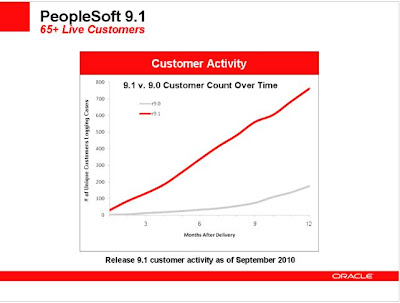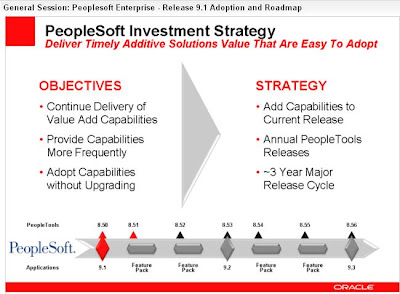Monday, October 25, 2010
What about a PeopleSoft App Store?
I've been mulling the idea of having an app store for PeopleSoft applications, similar to the Apple app store. Wouldn't it be great to have an online store where developers can upload bolt-on pieces and applications that have been created which customers can download and install in their PeopleSoft systems? I know that this is completely different from a typical ERP solution delivery, but I envision that such a concept will greatly help in enhancing PeopleSoft's popularity among customers. Fundamentally, this will also breed a group of developers or companies which would be pure app/product developers and I am sure that PeopleSoft customers will get to have some high quality add-ons which will enhance the usability experience. I am sure that this will happen some time, some day!
Sunday, October 17, 2010
Roadmap for PeopleSoft HCM product line
Here are two insightful slides from the Open world presentation on PeopleSoft HCM product line. It clearly underlines the commitment from Oracle to support PeopleSoft and come with newer releases more often. The adoption of 9.1 has been phenomenal as seen from the first graph and the decision by Oracle to deliver quicker feature changes bodes really well for the customer.
Figure 1: Adoption rate comparison between 9.1 and 9.0

Figure 2: Investment strategy on PeopleSoft product line - 9.2, 9.3 etc.

Figure 1: Adoption rate comparison between 9.1 and 9.0

Figure 2: Investment strategy on PeopleSoft product line - 9.2, 9.3 etc.

Saturday, October 16, 2010
Enterprise Time and Attendance product challenges
Most enterprise Time and Attendance systems (by enterprise T&A systems, I refer to time and attendance modules present in the larger HCM product line of an ERP suite and not stand alone time and attendance products) are mature products doing a very fine job of collecting and processing time. But recent advances in technology as well as changing patterns of employment and workforce present some very interesting challenges to traditional established Enterprise Time and Attendance softwares. An enterprise Time and Attendance system can no longer survive with a one-product-in-all strategy, simply because other systems have evolved over the last many years which are capable of performing certain aspects of time management much better than an enterprise Time and Attendance system. One of the major trends shaping the workforce today is the paradigm of the mobile/flexible workforce and the widespread influence of mobile devices and social networking. What is the best way to report/record time for a mobile workforce, living in the virtual social networking world? It is my solemn belief that the interface to report time will move to mobile devices or even social networking sites (think of recording an absence from a Facebook app! Weird, but in the current context an absolute probability) and the role of an enterprise Time and Attendance software as a time recording tool will fade to insignificance. To enable this shift, enterprise time and attendance products should come up with robust APIs for time reporting which any third party can consume and use.
Another major shift is in data analytics - traditionally time and attendance softwares come with very minimal data crunching and reporting abilities, while one of the major advantages of a T&A system is the insights time data can give into labour productivity and payroll costs. This is also a task better done by specialized data warehousing products, rather than the T&A product. This also makes sense as organizations are moving towards an integrated data warehousing strategy.
In short - enterprise time and attendance systems will mostly assume the role of a time processing engine and act as the critical bridging point between the time reporting layer and the reporting/analytics and other enterprise components like payroll and workforce scheduling systems. Below are my predictions on how enterprise T&A modules will evolve to meet the new challenges:

Another major shift is in data analytics - traditionally time and attendance softwares come with very minimal data crunching and reporting abilities, while one of the major advantages of a T&A system is the insights time data can give into labour productivity and payroll costs. This is also a task better done by specialized data warehousing products, rather than the T&A product. This also makes sense as organizations are moving towards an integrated data warehousing strategy.
In short - enterprise time and attendance systems will mostly assume the role of a time processing engine and act as the critical bridging point between the time reporting layer and the reporting/analytics and other enterprise components like payroll and workforce scheduling systems. Below are my predictions on how enterprise T&A modules will evolve to meet the new challenges:
- Separation of time reporting layer and time processing layer. Time reporting layer will move out of the enterprise T&A product, while the core strength of the T&A product will be time processing.
- APIs for integrating time data with time reporting interfaces. This should enable organizations the flexibility to report time using any mobile/social networking utility.
- Verticalisation of time and attendance solutions. Unlike other HCM processes, time management processes vary greatly across industries and a single configurable solution does not fit well. Enterprise T&A modules will have to verticalize their solutions.
- Stronger time based reporting and analytics and APIs with data warehousing products for time analytics. As organizations are moving towards a central data warehousing tool for all products used within the organization, I would like to see enterprise T&A module vendors forging stronger alliances with datawarehousing vendors and coming up with pre-defined data models, dashboards and reports.

KABA BCOMM integration with PeopleSoft Absence Management
KABA is one of the two certified time clock vendors for Oracle PeopleSoft Time and Labor. There is a bi-directional integration between KABA and T&L, with T&L sending the TCD (Time Collection Device) and time reporter data to KABA and KABA sending the punch/elapsed time data to T&L. The integration of KABA and Time and Labor is pretty seamless and my experiences with the product has been very satisfactory. In a recent product demonstration by KABA, I got to know that they are developing an interface with PeopleSoft Absence Management, which will allow users to book absences directly on the clock. According to the KABA account manager who was giving the product overview, the integration with Absence Management should be generally available by Q2 of 2011. This is an interesting development as it will ease absence reporting for employees in operational industries (like manufacturing/retail/hospitality etc.), integrate time and absence reporting to a single application, authenticate employees based on a badge/biometric data (thereby eliminating the need for employees to remember the username and password for various applications) and possibly eliminate the need for employees to spend time in a computer kiosk (with associated authentication, caching and security concerns). But, absence reporting is completely different from time reporting and it will be interesting to see how the product from KABA is positioned to deal with all the challenges. Nevertheless, it is a feature which customers would want to evaluate while deploying PeopleSoft Time and Labor and TCDs.
Subscribe to:
Posts (Atom)
